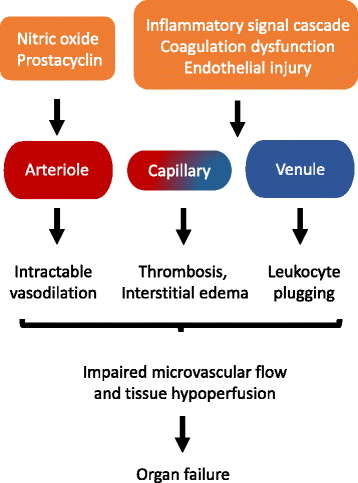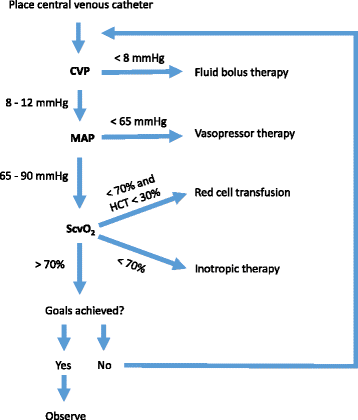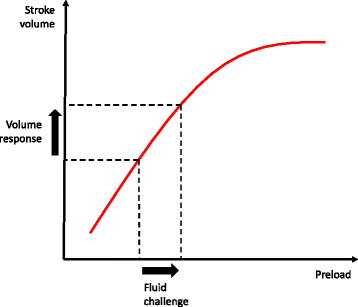Early goal-directed resuscitation of patients with septic shock: current evidence and future directions
- PMID: 26316210
- PMCID: PMC4552276
- DOI: 10.1186/s13054-015-1011-9
Early goal-directed resuscitation of patients with septic shock: current evidence and future directions
Abstract
Severe sepsis and septic shock are among the leading causes of mortality in the intensive care unit. Over a decade ago, early goal-directed therapy (EGDT) emerged as a novel approach for reducing sepsis mortality and was incorporated into guidelines published by the international Surviving Sepsis Campaign. In addition to requiring early detection of sepsis and prompt initiation of antibiotics, the EGDT protocol requires invasive patient monitoring to guide resuscitation with intravenous fluids, vasopressors, red cell transfusions, and inotropes. The effect of these measures on patient outcomes, however, remains controversial. Recently, three large randomized trials were undertaken to re-examine the effect of EGDT on morbidity and mortality: the ProCESS trial in the United States, the ARISE trial in Australia and New Zealand, and the ProMISe trial in England. These trials showed that EGDT did not significantly decrease mortality in patients with septic shock compared with usual care. In particular, whereas early administration of antibiotics appeared to increase survival, tailoring resuscitation to static measurements of central venous pressure and central venous oxygen saturation did not confer survival benefit to most patients. In the following review, we examine these findings as well as other evidence from recent randomized trials of goal-directed resuscitation. We also discuss future areas of research and emerging paradigms in sepsis trials.
Figures



Similar articles
-
Management of septic shock: a protocol-less approach.Crit Care. 2015 Jun 19;19(1):260. doi: 10.1186/s13054-015-0968-8. Crit Care. 2015. PMID: 26088759 Free PMC article. Clinical Trial.
-
A randomized trial of protocol-based care for early septic shock.N Engl J Med. 2014 May 1;370(18):1683-93. doi: 10.1056/NEJMoa1401602. Epub 2014 Mar 18. N Engl J Med. 2014. PMID: 24635773 Free PMC article. Clinical Trial.
-
Early Goal-Directed Therapy in Severe Sepsis and Septic Shock: A Meta-Analysis and Trial Sequential Analysis of Randomized Controlled Trials.J Intensive Care Med. 2018 May;33(5):296-309. doi: 10.1177/0885066616671710. Epub 2016 Oct 22. J Intensive Care Med. 2018. PMID: 27756870
-
The Effect of Early Goal-Directed Therapy on Outcome in Adult Severe Sepsis and Septic Shock Patients: A Meta-Analysis of Randomized Clinical Trials.Anesth Analg. 2016 Aug;123(2):371-81. doi: 10.1213/ANE.0000000000001278. Anesth Analg. 2016. PMID: 27049857 Free PMC article. Review.
-
[Early goal directed therapy in severe sepsis].Med Klin Intensivmed Notfmed. 2014 Nov;109(8):568-76. doi: 10.1007/s00063-014-0377-9. Epub 2014 Sep 28. Med Klin Intensivmed Notfmed. 2014. PMID: 25261188 Review. German.
Cited by
-
Advanced Hemodynamic Management in Patients with Septic Shock.Biomed Res Int. 2016;2016:8268569. doi: 10.1155/2016/8268569. Epub 2016 Sep 14. Biomed Res Int. 2016. PMID: 27703980 Free PMC article. Review.
-
Development and validation of an emergency bloodstream infection score for predicting in-hospital mortality in patients with community-acquired bloodstream infections.World J Emerg Med. 2023;14(4):280-286. doi: 10.5847/wjem.j.1920-8642.2023.067. World J Emerg Med. 2023. PMID: 37425085 Free PMC article.
-
STAPLAg: a convenient early warning score for use in infected patients in the intensive care unit.Medicine (Baltimore). 2020 May 29;99(22):e20274. doi: 10.1097/MD.0000000000020274. Medicine (Baltimore). 2020. PMID: 32481394 Free PMC article.
-
Association of Fluid Accumulation with Clinical Outcomes in Critically Ill Children with Severe Sepsis.PLoS One. 2016 Jul 28;11(7):e0160093. doi: 10.1371/journal.pone.0160093. eCollection 2016. PLoS One. 2016. PMID: 27467522 Free PMC article.
-
Serum Procalcitonin and Procalcitonin Clearance as a Prognostic Biomarker in Patients with Severe Sepsis and Septic Shock.Biomed Res Int. 2016;2016:1758501. doi: 10.1155/2016/1758501. Epub 2016 Mar 20. Biomed Res Int. 2016. PMID: 27088084 Free PMC article.
References
-
- Hall MJ, Williams SN, DeFrances CJ, Golosinskiy A. Inpatient care for septicemia or sepsis: a challenge for patients and hospitals. NCHS Data Brief. 2011;62:1–8. - PubMed
Publication types
MeSH terms
Substances
LinkOut - more resources
Full Text Sources
Other Literature Sources

